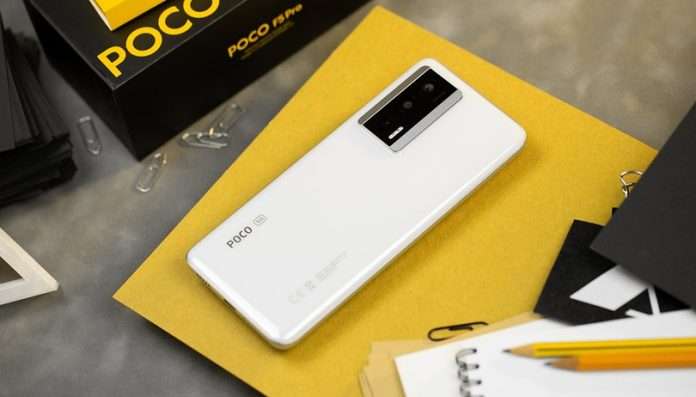- Xiaomi Poco F5 Pro data sheet
- Design: a well-known recipe that dates back?
- Screen: what we want in 2023
- Software: is MIUI 14 convincing?
- Performance: the major asset of the Xiaomi Poco F5 Pro
- Photo and video: it's not worth 600 euros
- Audio
- Network and communication
- Drums: correct autonomy, very good charge
- Xiaomi Poco F5 Pro price and date of release
The market for smartphones priced between 600 and 700 euros is ultimately uncompetitive. Few models are available at these costs if you look attentively. This tariff positioning is mostly filled by high-end cellphones introduced a year ago: we immediately think of the iPhone or Galaxy S, which are released at considerably higher costs but whose discounts allow them to be purchased at much lower rates. However, there are a few phones in this price bracket, such as the recently released Xiaomi Poco F5 Pro. A Xiaomi smartphone that embarks on Snapdragon 8 + Gen 1, a promising SoC that promises to perform well. We were able to put it through its paces to determine whether it should be preferred over a “old” high-end smartphone.
Xiaomi Poco F5 Pro data sheet
| Model | Xiaomi Poco F5 Pro |
|---|---|
| Dimensions | 7.54 cm x 16.28 cm x 8.59 mm |
| Manufacturer interface | MIU |
| Screen size | 6.67 inches |
| Definition | 3200 x 1440 pixels |
| Technology | AMOLED |
| SoC | Qualcomm Snapdragon 8 + Gen 1 |
| Graphic chip | Adreno 730 |
| Internal storage | 256 GB, 512 GB |
| Photo camera ( dorsal ) | Sensor 1: 64 MP Sensor 2: 8 MP Sensor 3: 2 MP |
| Front photo sensor | 16 MP |
| Video recording definition | 8k |
| Wi-Fi | Wi-Fi 6 ( ax ) |
| Bluetooth | 5.3 |
| 5G | Yes |
| NFC | Yes |
| Fingerprint sensor | Under the screen |
| type connector | USB Type-C |
| Battery capacity | 5160 mAh |
| Weight | 204 g |
| Colors | Black white |
Design: a well-known recipe that dates back?
In terms of design, it is evident that the Poco F5 Pro does not reinvent the wheel. The rear side is smooth and has a glossy covering. It should be noted that our white test version does not collect fingerprints particularly well, which is unusual. We are entitled to the brand name as well as the mention ” 5G ” on the left side; it is not necessary, but it is there. The picture block in a rectangular shape is clearly visible. The two vertical borders in metallic gray that frame the sensors are certainly the most startling feature. The inside of this frame is still more traditional, with an induction plate that houses two picture sensors.

This glass-covered back face curls on both sides to join a metallic gray strapping, which comes to take up the whole thickness on the bottom and top borders. This gray / off-white two-tone appears antiquated in 2023 and lacks elegance, but it is not truly dated. What should we do to bring the screen to the front? Its edges are very decreased, notably its relatively narrow chin. Other manufactures outperform at this price point, but these thicknesses remain accurate. Again, the selfie camera is situated in a punch at the top of the screen in the centre, which is extremely traditional.
It measures 162.78 by 75.44 by 8.59 mm. It’s not the tiniest model available, but given the battery and performance it provides, we can’t blame it. It’s also fairly light in weight: 204 g, which makes it neither a featherweight nor a heavyweight. Finally, the finishes are excellent, despite the fact that the buttons tend to shift as a result of the game. When we hold the F5 Pro in our hands, we get the sensation that it is substantial.
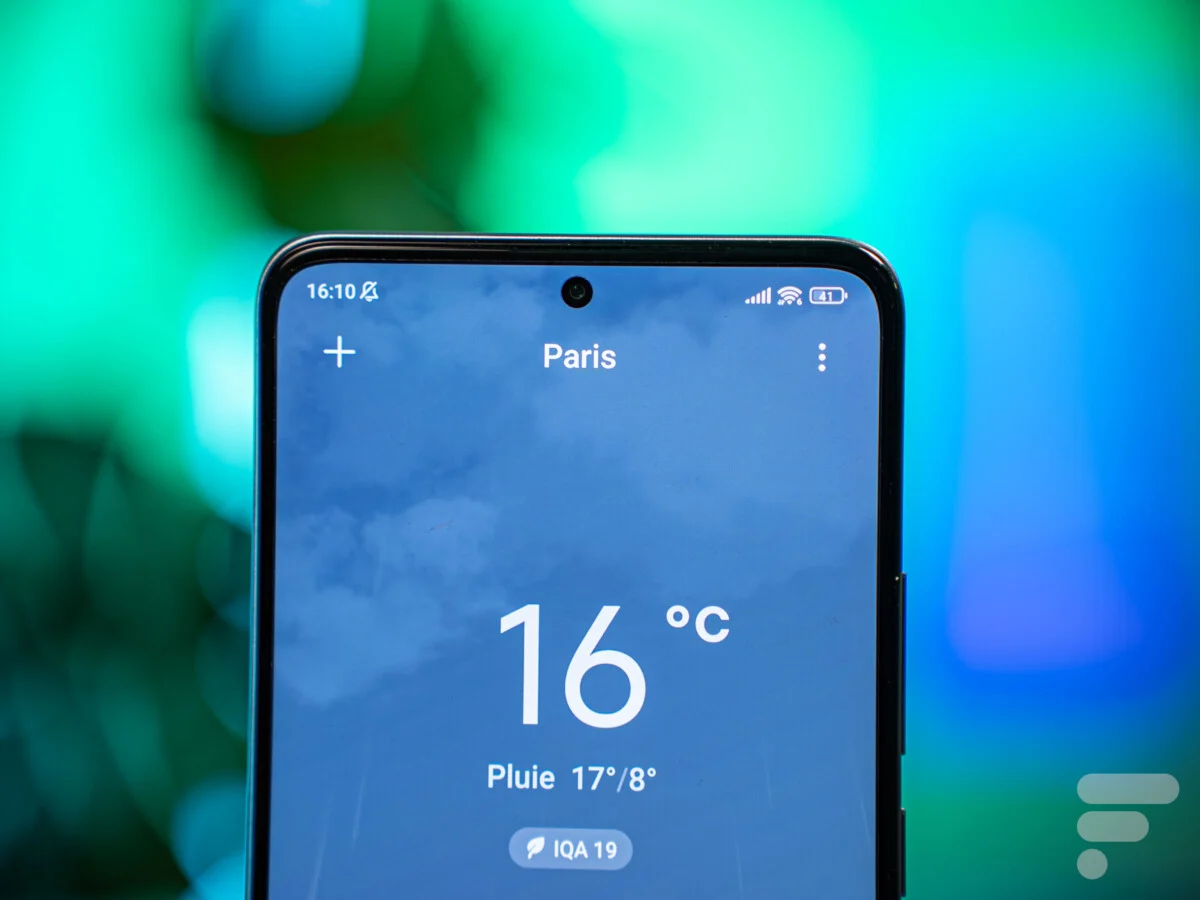
On the durability front, this smartphone has a Corning Gorilla Glass 5 glass, which is necessary of a respectable model in 2023. There is also an IP53 certification, which implies that this gadget is substantially (but not completely) protected against dust and water splashes. On this front, it obviously falls short of what we are entitled to expect from a smartphone. This Xiaomi Poco F5 Pro comes in two colors: black and white.
Getting started with the Xiaomi Poco F5 Pro
We have a strong grasp on the Poco F5 Pro thanks to this metal outline, this border that connects the screen and the back face. Because it is little rough, it allows you to hang your fingers. In a nutshell, we’re not scared to throw it on the ground. However, its huge format with a 6.67-inch screen will not appeal to everyone, particularly those with little hands. There is another issue with this eventually imposing photo block: it is impossible to operate the smartphone when it is placed on a table since the block unbalances it. Even if you just want to send a message by tapping on the keyboard, this is the situation.

In terms of button accessibility, the power button is excellent, but the volume buttons, particularly the top button, are not. Again, be wary of folks with little hands.
There are various ways to unlock the F5 Pro. First, there’s the fingerprint sensor, which is placed beneath the screen. It’s simple to set up; simply press your finger on it numerous times. In usage, it’s also satisfying since, with a reactive trigger, you don’t have to wait for it to trigger. The same is true for facial recognition, which may be activated even if the smartphone is slightly inclined and our face is not directly in front of the camera.
Screen: what we want in 2023
The screen of the Poco F5 Pro has a lot going for it: it’s a 6.67-inch (every traditional diagonal) AMOLED panel with WQHD Plus resolution (3200 by 1440 pixels). It has a refresh rate of 120 Hz and an adjustable mode that can go down to 60 Hz. Unfortunately, the screen does not go much farther on this point; we would have like for the fresh rate to decrease more and for it to be really flexible. The auto-brightness is responsible and reasonably gradual; adjustments aren’t abrupt, and the program mostly merely aims.
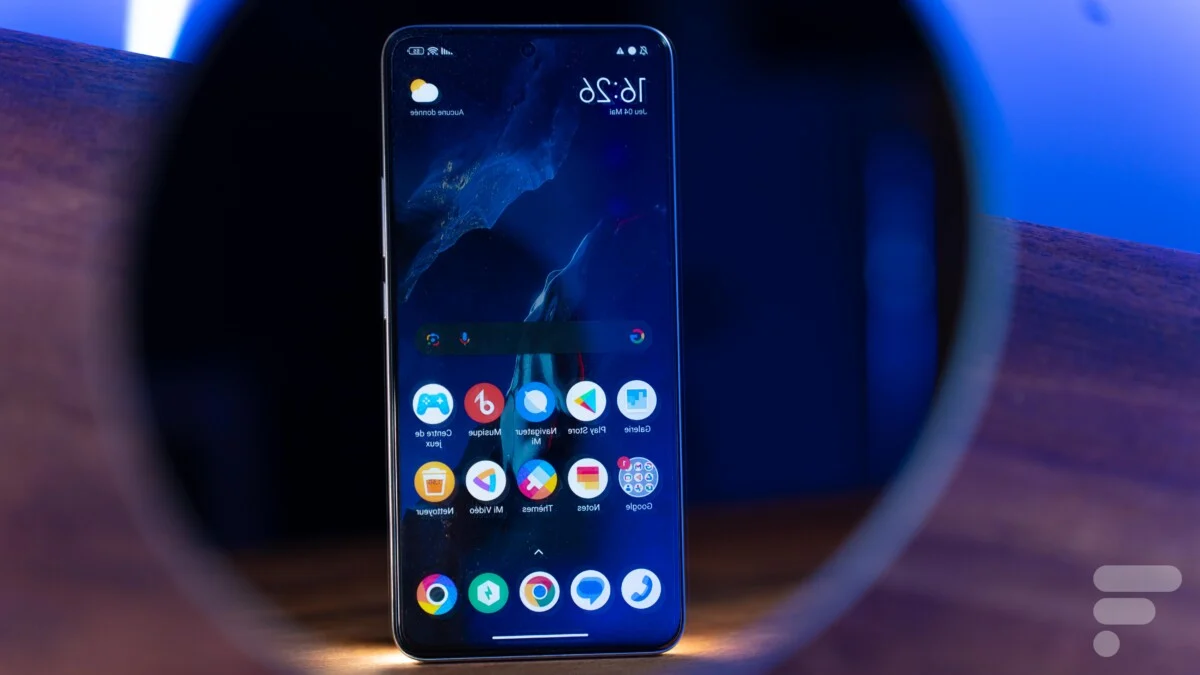
According to the manufacturer, it covers all of DCI-P3. Color calibration appears to be proper, and while you may expect the Poco F5 Pro to pull blue before using it, this is not the case. The redder tones also stand out, and the blue tones are not as chilly.
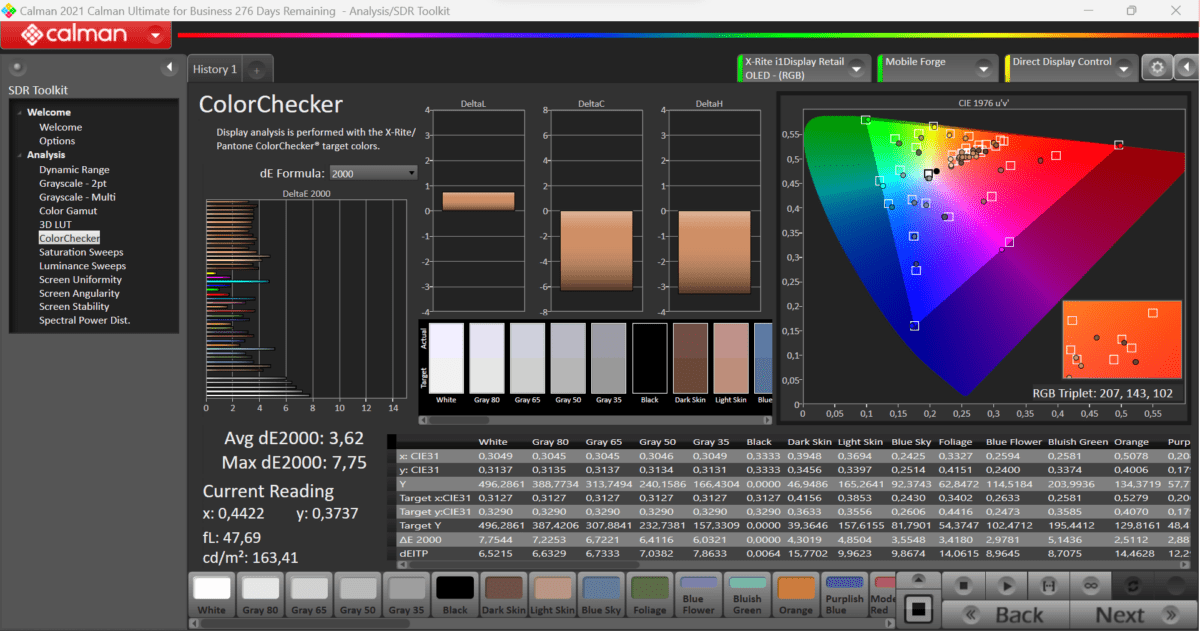
it is imperceptible for the user. human eye. Attention, it should be noted that the white and gray tones exceed 6 in Delta E and even reach 8. In HDR, the average Delta E is less good, but it is logical: 7.12, it is not noticeable to the user. The human eye. It should be observed that the white and gray tones in Delta E transcend 6 and even approach 8. The average Delta E in HDR is less excellent, but it is logical: 7.12.
Software: is MIUI 14 convincing?
Who says Xiaomi smartphone means MIUI: here’s MIU 14 with a slew of new features, running on Android 13. What distinguishes MIUI 14 from other interfaces is clearly the separation of alerts and quick settings. Although I do not agree with this clause, I see why other people do.
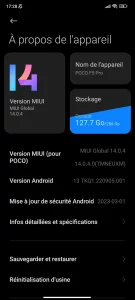

MIU 14, like all other Android interfaces, works fine, and I haven’t come across any issues. The animations are fluid everywhere and at all times, and menu navigation is simple because to colorful cons in settings and fast settings with large icons (thanks to the control center that separates from alerts).


Our programs are split over several pages on the home screen, but to access all of those installed, simply move your finger from the bottom up to open the application drawer. You may also review them letter by letter by using the slider on the right: each program beginning with a given letter is highlighted, darkening the icons of other apps. What to look for for those who want to increase them.



It’s Monet, the function that enables you to synchronize the colors of the interface (buttons, program icons, curves, etc.) with those of the backdrop, that we like to see on the latest Android handsets. Unfortunately, MIUI 14 does not provide it, at least not in a significant way. Only the colors of the icons may be changed, and only from a restricted palette of blue, green, purple, and brown. Apart from that, we can clearly see the Chinese influence in MIUI 14: we have a type of theme and wallpaper shop to download, a community application that connects Poco smartphone users, and so on. There are also chores and colors there.


In retrospect, while the customizing choices are many, which is a positive thing, some titles are not particularly explicit. Furthermore, certain choices are concealed under sub-menus with names that do not suggest that they would be located there. What if you get a bit lost in all of the Poco F5 Pro’s parameters?

Last but not least, Game Turbo, which not only makes it quicker to reach rapid settings than through the control center, but also allows you to move to another program. The most intriguing choice is certainly the one that improves performance from the start. When enabled, you may see the number of frames per second shown.
There are still a specific amount of preloaded third-party applications: thirteen, excluding Xiaomi applications. We don’t ask for all of that if it isn’t necessary upsetting. Rest assured that you can watch your favorite programs and movies on any SVoD platform since the Xiaomi Poco F5 Pro is Widevine L1 DRM compliant, ensuring that you can view them in HD.
Unfortunately, the manufacturer was unable to provide us with a response about the duration of the phone’s upgrade. As a result, we can only expect two major Android releases and three years of security fixes. It is unfortunate that Xiaomi does not explain more on this subject, which will be crucial in 2023.
Performance: the major asset of the Xiaomi Poco F5 Pro
To run the Poco F5 Pro, we have a Qualcomm SoC, the Snapdragon 8 + Gen 1, which was still at the top of the line last year. It is engraved in 4 nm and consists of an eight-core CPU running at 3 GHz and an Adreno GPU. Depending on the LPDDR5 version, we are entitled to 8 or 12 GB of RAM. To go even farther, we may activate 3 GB of virtual RAM from the smartphone’s flash memory, which does not deliver as much power. We also have a Liquid Cool 2.0 vapor chamber, which is pretty uncommon in this price bracket, so Xiaomi deserves credit for that. In practice, it allows the components to prevent overheating.

In reality, this leads to a more fluid smartphone while starting programs, switching between apps, and so on. It is extremely efficient for traditional usage. But what about avaricious video games? We tried out Genshin Impact and had a 20-minute control session. The game usually always manages to operate at 60 FPS in “High” quality: when a lot of objects are presented, there are minor slowdowns, but nothing significant. Similarly, at high graphic quality and with HD textures, we get an almost continuous 60 FPS (except in cities with a lot of objects to display). However, the Poco F5 Pro tends to overheat quickly, especially after 10 minutes of play. It’s not enough to be roaming, but it’s worth mentioning.
| Model | Xiaomi Poco F5 Pro | Xiaomi Poco F4 GT | Oppo Reno 8 | Google Pixel 7 | Realme GT Neo 3 |
|---|---|---|---|---|---|
| AnTuTu 9 | 1027278 | 967292 | 568350 | 713948 | 822636 |
| AnTu CPU | 242321 | 213974 | 124542 | 188925 | 201733 |
| AnTuTu GPU | 462496 | 418248 | 227540 | 281639 | 312601 |
| AnTu Tu MEM | 153897 | 168949 | 105162 | 99164 | 149301 |
| AnTu Tu UX | 168564 | 166121 | 111106 | 144220 | 159001 |
| PC Mark 3.0 | 13692 | 12644 | 9607 | 10292 | 14370 |
| Geekbench 6 Single-core | 1296 | N / C | N / C | N / C | N / C |
| Geekbench 6 Multi-core | 3856 | N / C | N / C | N / C | N / C |
| Geekbench 6 Compute | 5521 | N / C | N / C | N / C | N / C |
| Sequential Read / Write | 1709.82 / 1044.46Mo / s | 1827/1436 Mo / s | 1726/1243 Mo / s | 1299/910 MB / s | 1751/1333 MB / s |
| Random read / write | 296.7 / 298.75 IOPS | 81885/110291 IOPS | 54,000/64,000 IOPS | 50855/63915 IOPS | 74087/80379 IOPS |
Based on the results of the benchmarks, it is evident that the Poco F5 Pro’s major asset is its performance. It outperforms comparable priced competitors in practically every test. Given the RAM and processor available, this was to be anticipated for this smartphone.
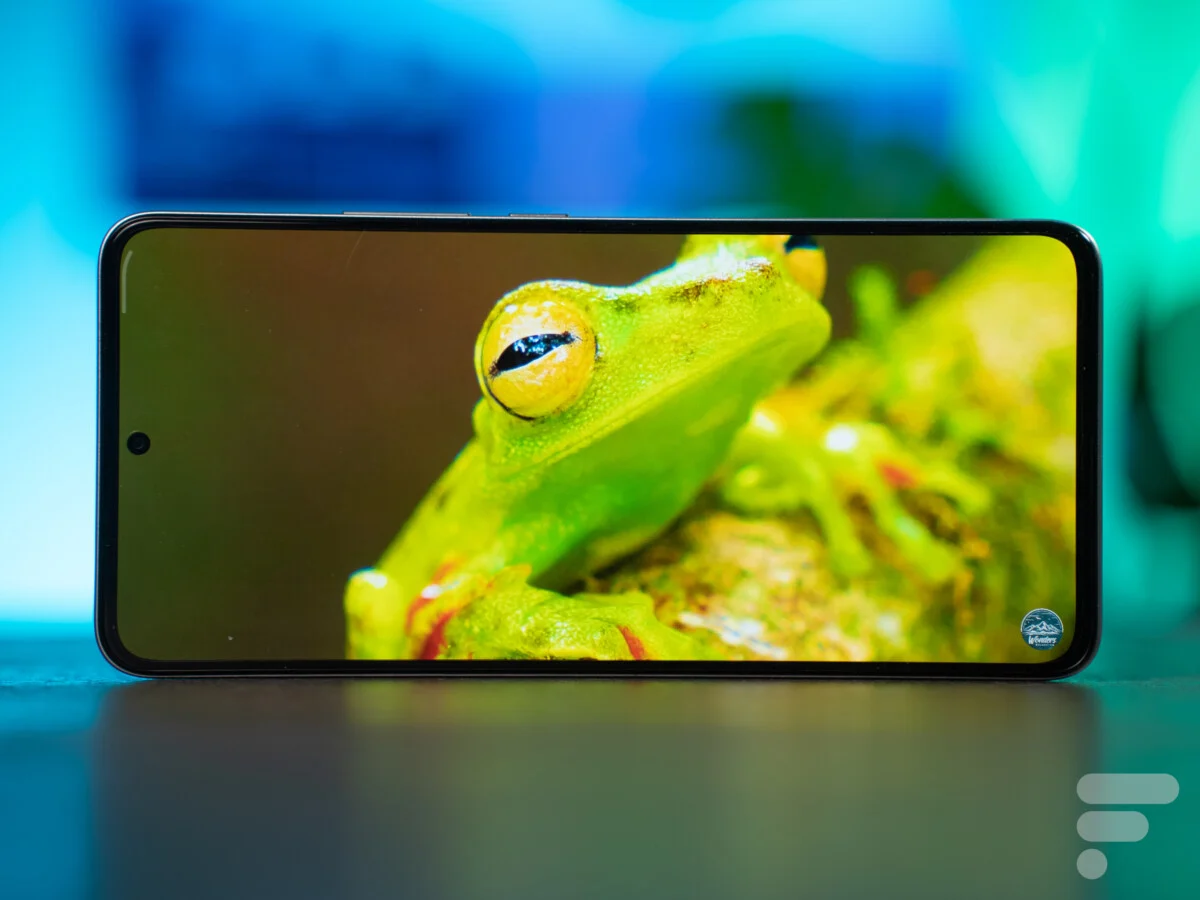
In terms of storage, depending on the model, the Poco F5 Pro features 256 or 512 GB of UFS 3.1 storage that is not extendable through microSD card. Even though it is sufficient to hold several video games and other huge files, we cannot consider this capacity to be a true advantage of the smartphone. However, it would have been a disadvantage if it had supplied a 128GB version.
Photo and video: it’s not worth 600 euros
In terms of photography, the Poco F5 Pro has many photo sensors:
- A main sensor of 64 Mpx, f / 1.79;
- An 8 Mpx ultra-wide-sensor angle, f / 2.2;
- A 2 Mpx, f / 2.4 macro sensor;
- At 16 Mpx selfie sensor, f / 2.45.
Sensor hand
The primary sensor is typically fine; it does the job: sharpness, colors, practically everything is present. However, upon closer inspection, we see several minor defects that are regretful for a product costing more than 600 euros. Some photos have a greenish yellow tint to them, and the color of the grass and vegetation in general is excessively emphasized. We got the sense that this was done “on purpose,” because the smartphone might have pushed the gold dome of the Hôtel des Invalides, but it did not.
The crispness is absolutely right, despite the fact that the Pocos have rarely habituated us to this quality. If you look closely, you’ll see that certain corners have lost a little sharpness: this isn’t a big deal. Even though the ISO management is good at night, the digital processing smooths the textures too much, causing information to be lost.
It must be acknowledged that overall color management is good. On the other hand, the smartphone struggles to manage dynamics, particularly in dark areas: it occasionally fails to retrieve any detail when another model might.




Finally, the shutter speed is occasionally excessively slow: in order to avoid increasing the sensitivity to light, the sensor may reduce this speed. The issue is that some shots are hazy.
Ultra-wide-angle sensor
We rapidly notice a colorimetric discrepancy between the primary sensor and the ultra-wide-angle sensor. However, the most serious problem with the latter is the high prevalence of chromatic aberrations. Even in excellent lighting, you can see it fairly well. Which is a terrible shame, because the colors are otherwise fairly excellent. The sensor often lacks light, as seen by fuzzy edges and a lack of sharpness.
If we can excuse the modest faults of the primary sensor, the ultra-wide-angle sensor’s flaws are far too great for a smartphone costing 600 euros.




Let’s move on from this sensor, which doesn’t need any debate. It is awful in 2023 with a definition of 2 MP, and the colors are bland, making attention difficult. We anticipated to be let down, and we were.


sensor selfie
That is not the case with selfies. We may excuse them for having a foggy effect, especially in low-light situations. Even if it has an effect on the colors, the sharpness remains. In dark conditions, however, such crispness is greatly reduced, with grit appearing, albeit unobtrusively. Even if we consider the selfies to be acceptable, their quality is inadequate for a smartphone at this price, especially when compared to Pixels or Samsung devices.
Video
The Poco F5 Pro can record videos up to 8K, or 4K.
Audio
There is no jack port for listening to music, thus you must use an adapter or wireless devices with Bluetooth codecs. Because ludspeakers are typically excellent, using them will not constitute a flaw. First and foremost, they are stereo, and the power between the bottom and upper speakers is comparable: enough to provide balanced audio regardless of how the Poco F5 Pro is held.
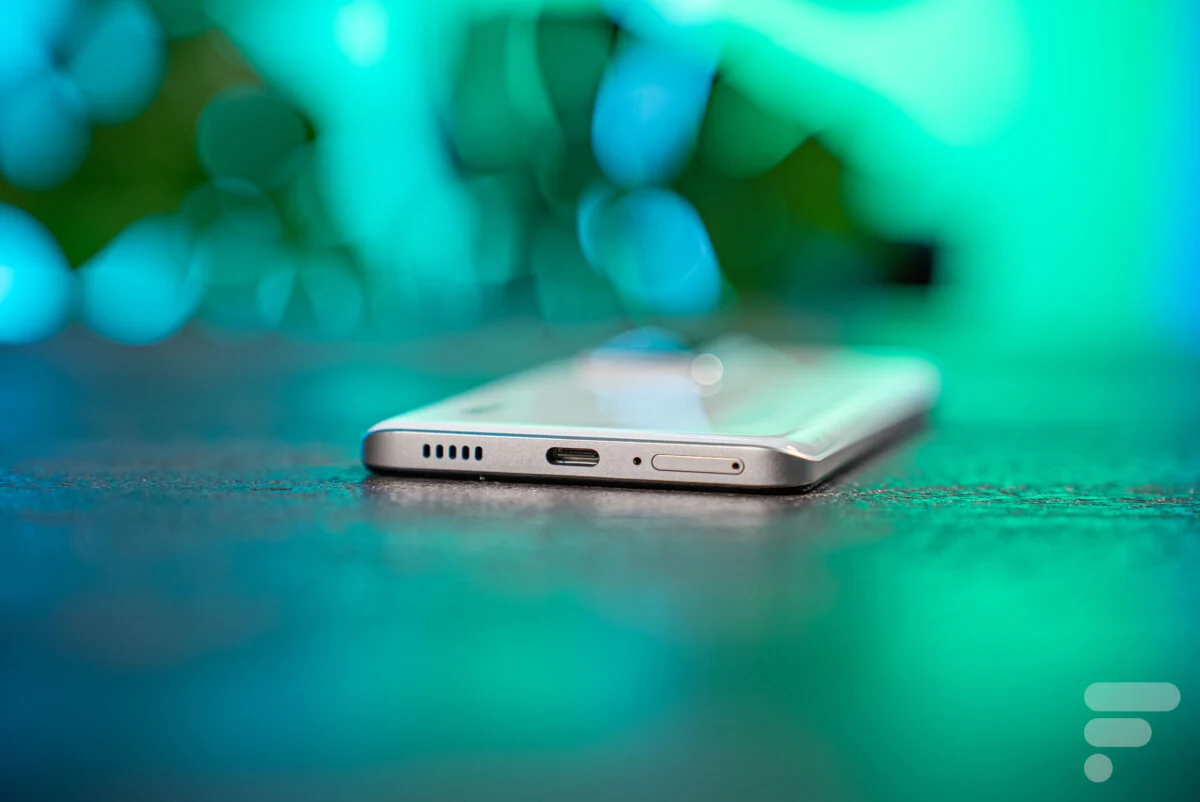
In actuality, it does not stand out for its bass, which is difficult to detect, but it provides enough for us to experience depth in the music we listen to. The sound is somewhat affected by accurate midrange, and while the highs are occasionally overpowering, they remain where they should be. Of course, at 70% of maximum level, the sound distorts significantly, especially if the gadget is close to our ears. To summarize, the Poco F5 Pro can easily cover a room, but not much more.
Network and communication
This Xiaomi smartphone is 5G ready, has Wi-Fi 6, NFC, and Bluetooth 5.3. In summary, everything you could want in terms of connection in 2023. For calls and SMS, two nanosIM cards can be used and stored in the designated drawer in the smartphone’s lower area.
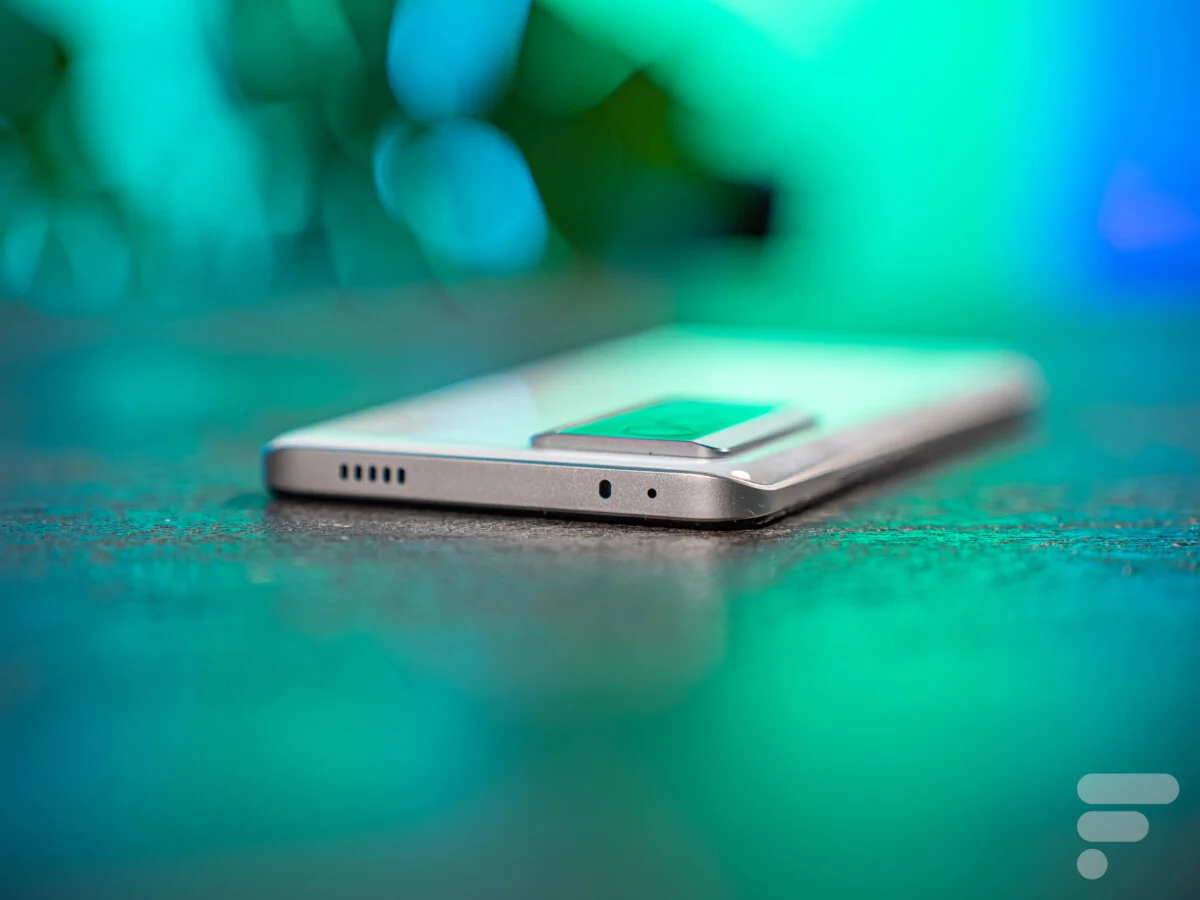
In terms of call quality, it is excellent. Even in a loud setting, such as a street with automobiles starting or moving, the speech is adequately insulated. Furthermore, she is not as squeezed, and when you stop talking, the microphone does not turn off too soon or too late. It’s also fairly excellent at wind management: if we can hear it blowing, it stays confined, and our interlocutor hears us clearly. Finally, the Poco F5 Pro handles echo, but it may be detected faintly.
Drums: correct autonomy, very good charge
This phone is powered by a battery with a capacity of 5,160 mAh, which is somewhat more than the norm in force of 5,000 mAh. According to the manufacturer, the maximum endurance on appeal is 34.5 hours, 20 days of standby, 24 hours of reading, and 20 hours of video.
I lost 9% autonomy during a 20-minute playing session on Genshin Impact, a 3D video game that requires a lot of resources. In Fortnite, I lost 11% battery under the identical conditions. It’s really decent for a smartphone, and it’s most likely due to the large battery.

Even with the smartphone on all the time and at a reasonable brightness, holding the day and a half will not be a problem in more diverse use. They can arrive with two days of use for the most cost-effective or those who use their smartphone for less than four hours every day.
As a result, the Xiaomi F5 Pro is a delightful endurance model. To get a more objective sense of its autonomy, we put the Poco F5 Pro through an endurance test using our Smart ViSer (protocol that simulates human activities utilizing the) device, which all of the smartphones we evaluate pass. This model lasted 12 hours and 56 minutes before attaining 10% autonomy, placing it in the middle of the pack.
Recharge
On the load side, the USB-A cable to USB-C and the sector adaptor included allow you to reach 67 W of power. Xiaomi claims that up to 50% of the battery may be recharged in 32 minutes. However, we have the right to wireless charging with a maximum power of 30 W. Here’s how a full charge begins at 10% of the remaining battery capacity:
- 0 minute: 10%
- 10 minutes: 48%
- 20 minutes: 71%
- 30 minutes: 87%
- 40 minutes: 95%
- 50 minutes: 100%
If increasing the load to 100% takes some time, increasing it to 90% takes only a little more than 30 minutes in our test. Aside from comfortable autonomy, the Xiaomi Poco F5 Pro has a charge that allows you to regain a day’s autonomy in 15 minutes.
Xiaomi Poco F5 Pro price and date of release
The Poco F5 Pro was released on May 9, 2023 in black and white colors. Here are the different versions and prices :
- 8 GB of RAM and 256 GB of storage: 579.90 euros.
- 12 GB of RAM and 256 GB of storage: 629.90 euros.
- 12 GB of RAM and 512 GB of storage: 649.90 euros.


